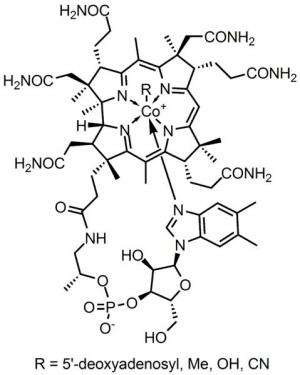Researchers locate the body's largest cell receptor

A giant toadstool that swallows up vitamins and nutrients in the intestines and kidneys: This is how one receptor that absorbs B12 vitamins in the small intestine looks. For the first time, researchers from Aarhus University, Denmark, have an insight into an as-yet unknown biology which has persisted for hundreds of millions of years of evolution.
"What we're looking at is evolution at a structural level. A receptor with a toadstool structure that stems from way back to the common ancestors of insects and humans," says Associate Professor Christian Brix Folsted Andersen from the Department of Biomedicine at Aarhus University in Denmark.
Vitamin B12 is the vitamin that humans most often lack, even with a healthy diet, which in turn can lead to serious anaemic diseases and symptoms from the central nervous system. With his research group, Andersen has now described the body's largest cell receptor: An ancient, previously unknown construction that was created by the merger of two proteins, and which, for reasons scientists do not yet understand, is preserved as a colossal structure in molecular terms.
In the 1960s, scientist Dorothy Hodgkin received the Nobel Prize for her scientific breakthrough in determining the structure of the B12 vitamin. Now, Andersen and colleagues report this receptor structure more than 1000 times larger, which enables B12 to be absorbed in the body. The research results have been published in the scientific journal Nature Communications, and shed light on the issue of faulty vitamin B12 absorption and the loss of nutrients in the kidneys.
"With the help of X-ray crystallography, we've succeeded in determining how the receptor is able to organise itself in a previously unknown way in human biology. With this new knowledge, we're finally able to explain why thousands of people around the world with specific genetic changes are unable to absorb the vitamin," explains Andersen over the phone from the University of Washington in the U.S.
"But in my mind, the most interesting aspect is that with the help of advanced electron microscopy, which I'm learning about in detail here in Seattle, we have been able to see how the receptor as a whole looks, and thus also see how the receptor absorbs B12 vitamin in the intestines and various other substances in the kidneys. It's fantastic to have the opportunity to see this as the first person ever," he says.
Andersen points out that in an evolutionary context, there is something very mysterious about the receptor as it does not resemble anything seen previously. "At the same time, by comparing genes, we can see that the receptor has the same structure as we find in insects and that it must have been evolved very early in evolution—many millions of years ago, and thus long before the origin of mammals," he says.
Andersen's research is a continuation of his longstanding work with Søren K. Moestrup into B12 transport. In 2010, this research led to new and pivotal knowledge about how the receptor specifically recognises B12 in the small intestine.
"The research we're carrying out today is a continuation of decades of research into vitamin B12. Indeed, 25 years ago, we had no idea about what was going on the shadowy recesses of the intestines. Now, the lights have been turned on, and we can see how it all works in a way that none of us could have imagined," says Moestrup.
"Apart from obviously being very satisfying from a scientific viewpoint, it also opens completely new perspectives for medical treatment. For example, we now have in-depth knowledge about a receptor that could evidently be used to transport drugs into the kidneys and intestines," he says.
More information: Casper Larsen et al, Structural assembly of the megadalton-sized receptor for intestinal vitamin B12 uptake and kidney protein reabsorption, Nature Communications (2018). DOI: 10.1038/s41467-018-07468-4
Journal information: Nature Communications
Provided by Aarhus University




















